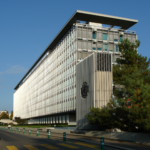Of quarantines and robots: How smart are US and Chinese efforts to combat the Wuhan coronavirus?
By Saskia Popescu | January 28, 2020
 People in protective suits at a health checkpoint in Beijing. Credit: Pau Colominas via Wikimedia Commons. CC BY-SA 4.0.
People in protective suits at a health checkpoint in Beijing. Credit: Pau Colominas via Wikimedia Commons. CC BY-SA 4.0.
As officials in countries around the world race to respond to an outbreak of the new coronavirus that originated in Wuhan, China, they’ve been implementing measures ranging from mass quarantines to robotic patient care to halt the spread of the disease—methods that may prove ineffective or worse in limiting future infections.
So how effective are the methods used in China and the United States likely to be?
The Chinese response. Officials have been more open about how they’re responding to the new coronavirus crisis than they were during the 2003 outbreak of Severe Acute Respiratory Syndrome (SARS). In 2003 the government waited months to disclose the outbreak; this time, however, officials in Wuhan publicized cases of the disease on New Year’s Eve, within a month of when the virus is believed to have first infected people. Since then Chinese government officials have been quick to take actions like quarantining cities and sharing details about the virus.
That being said, some have questioned the government’s reporting on the coronavirus. The official efforts to shut down “rumors” gave the initial impression that the outbreak was small. And the government has reversed its claim that there was no human-to-human transmission. On January 22, when Chinese authorities were reporting 440 cases of the disease, researchers at Imperial College London estimated there were actually 4,000. Since then the government’s official numbers have soared, with China’s health commission reporting more than 4,500 cases as of Tuesday.
Now that China is taking aggressive action to combat the spread of the coronavirus, it’s worth assessing the country’s response.
China is restricting travel into and out of cities in Hubei province, where Wuhan is located, an unprecedented quarantine that covers about 50 million people. While China didn’t implement a province-wide quarantine during the SARS outbreak, officials did isolate thousands of people. Canadian authorities also tried to quarantine some 27,000 people in Toronto during the 2003 crisis. During the quarantine, officials missed cases of the disease, mistakes that potentially led to further infection. It was a heavily criticized effort, and perhaps predictably so. Quarantines are difficult to pull off and not considered particularly effective, especially with diseases like SARS or the new coronavirus. The US Centers for Disease Control and Prevention, for instance, considers them a measure of last resort. Beyond the logistics issues, a mass quarantine can sow distrust in government and social discord, as it did, for instance, when residents of one Liberian neighborhood fought back against restrictions during the 2014 Ebola outbreak.
Moreover, a quarantine is effective when infected people are contagious before they show any symptoms (or soon after their symptoms begin)—meaning that they can spread the disease before they even realize they’re sick. While Chinese officials reported on Sunday that the new virus can indeed spread from people who aren’t showing any symptoms, researchers are still determining if this is possible or not. Anthony Fauci, the director of the US National Institute of Allergy and Infectious Diseases, said at a news conference Tuesday that even if people without symptoms are contagious, they won’t be a major factor in fueling an epidemic. “The driver of outbreaks is always a symptomatic person,” he said.
These types of viruses are typically transmitted through the respiratory secretions of an infected person—often spread via coughing and sneezing—and people are not considered contagious until they show symptoms. Overall, the data on the new coronavirus do not indicate that it is spreading among people with the speed that generally requires a quarantine to effectively address. But the outbreak is still in its early stages, and more than a few questions about the virus haven’t been fully answered.
Some experts don’t view the quarantine negatively, noting that residents of Wuhan, which has a population of 11 million people, can still move about their city. Given that the mayor of Wuhan has reported that about 5 million residents have already left, the quarantine strategy may be doomed from the start.
Chinese authorities are also attempting to isolate patients in designated facilities. In response to the staggering volume of cases, they are racing to build a hospital in six days to treat coronavirus patients. Toronto designated SARS hospitals, and West African countries opened Ebola facilities during past outbreaks. It’s critical that if fever checkpoints are used to send people to coronavirus hospitals, health authorities take care to avoid spreading the disease to people who might have something else, like the flu.
The US response. Although many US citizens in Wuhan hope to be evacuated from the city on a US government charter flight, the United States also faces serious challenges in responding appropriately to the new coronavirus, officially abbreviated as 2019-nCoV. As of Sunday, five cases have been reported in the United States. One of the first countermeasures US officials took was to screen passengers arriving from Wuhan at a handful of airports. But airport screenings are not precise. We’re in the midst of a serious flu season, and passengers with influenza could get wrongly identified as being potentially sick with the coronavirus. (The symptoms can be similar.) On the other hand, travelers might have the coronavirus but not be showing symptoms.
Airport screenings, however, can help educate people who might be sick and encourage them to seek care if they have symptoms following travel to affected regions.
The first case of the coronavirus in the United States received wide news coverage, and rightly so. But the Providence Regional Medical Center in Everett, Wash., used some extreme techniques to treat the patient, a man in his 30s who’d travelled to Wuhan. He was taken from an urgent care to the hospital in a negative-pressure transportation device called an ISOPOD that’s more often associated with Ebola care and put into an isolation room, where the hospital used a robot to treat him to reduce health care worker exposure.
At this point, though, these extra precautions aren’t required. The Centers for Disease Control and Prevention notes that health care workers caring for patients with coronavirus should protect themselves with a gown, gloves, eye protection, and an N95 mask, which can filter out most airborne particles. If the Everett hospital wanted to use its robot and ISPOD to test its capabilities and protocols, it should have communicated this more clearly–to keep from confusing other health care providers about the advice of federal officials.

Like most countries, the United States is actively working to prevent additional cases of the Wuhan coronavirus by rapidly identifying and isolating people who have traveled to Wuhan and who have symptoms or relevant exposure. Reinforcing infection-prevention efforts to control the spread of the disease in hospitals and among the public at large is vital. For health care workers and public health officials, these strategies are not novel skills; they were honed during the 2002/2003 SARS outbreak, when health systems practiced basic infection-prevention efforts daily.
Instead of using robots and other extreme measures, reinforcing the best practices of infection prevention and good communication will be key to preventing a serious coronavirus outbreak in the United States.
Read more Bulletin coverage on the Coronavirus outbreak here.
Together, we make the world safer.
The Bulletin elevates expert voices above the noise. But as an independent nonprofit organization, our operations depend on the support of readers like you. Help us continue to deliver quality journalism that holds leaders accountable. Your support of our work at any level is important. In return, we promise our coverage will be understandable, influential, vigilant, solution-oriented, and fair-minded. Together we can make a difference.
Keywords: 2019-nCoV, Coronavirus, Ebola, SARS, Wuhan, epidemic, infection prevention, outbreak
Topics: Analysis, Disruptive Technologies
















The Chinese doctors have not found patient zero so far, which means they have not identified the origin of this coronavirus outbreak. Their viral genome study showed that the Wuhan wild animal market was not the origin of the spread of disease, instead they inferred, based on the genome from each and every early patient, the origin could be from a patient in Shenzhen or another patient inside the US, and spread of disease had occurred as early as the mid of November, rather than Dec 8, 2019.